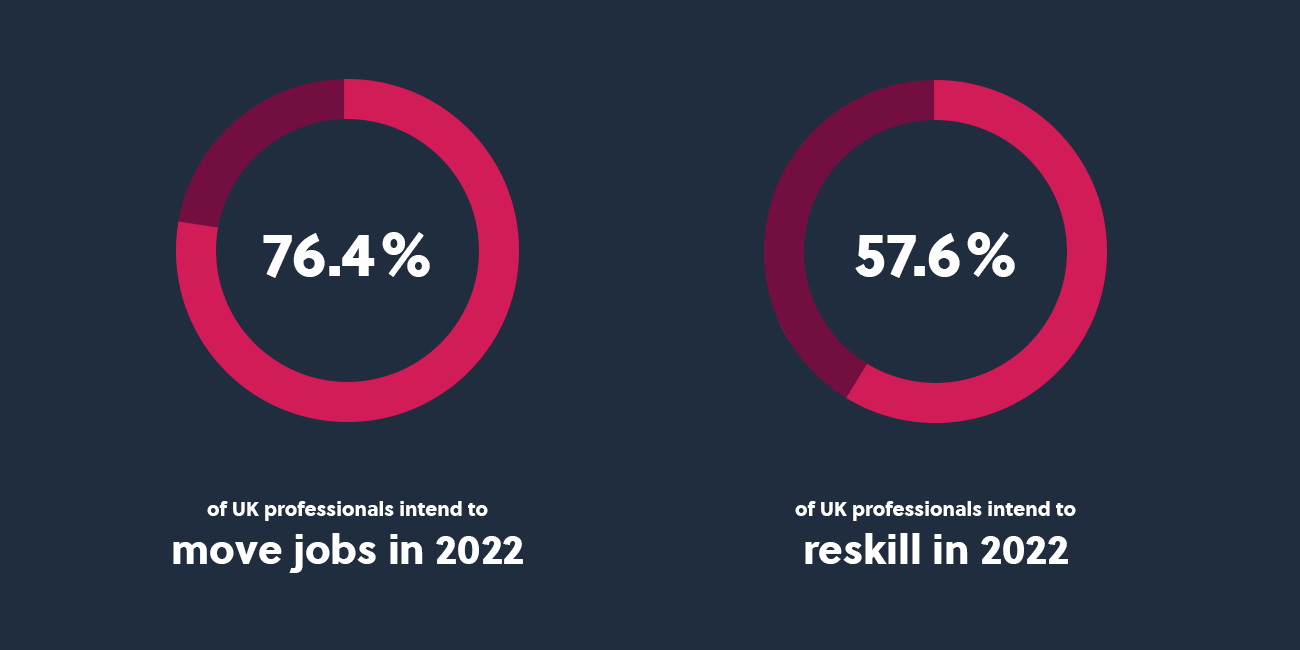The Great Reshuffle: Why So Many Professionals Are Moving On
As evidenced in the analysis carried out within our 2022 Salary Survey, we have entered a highly competitive era for the hiring market across all sectors, with employers now needing to offer a whole host of perks, incentives, and opportunities in order to stand out from the crowd, such as enhanced employee benefits, increased work-life balance and flexibility, as well as ever-increasing salaries (to name but a few).
As a result of the increase in these attractive incentives, many professionals are taking the opportunity to find a better-suited position; in fact, data from the Microsoft 2021 Work Trend Index found that 41% of workers around the world were considering changing their current role within the next year. But, in spite of this, there are still some professionals who are totally unaware of their market value and have yet to consider whether a new role could offer them more. In this article, we’ve highlighted 5 of the most common factors candidates are citing as the catalyst that is pushing them to consider a new opportunity.
Flexibility & Futureproofing
In spite of the advances in technology and the massive overhaul in working practices that recent years have wrought, there are still some companies that have failed to embrace the innovative new business practices that have changed the way so many of us now work. Instead, these companies are insisting on returning to old and outdated work models: for example, insisting workers return to the office full-time, not allowing for flexible or hybrid work patterns and failing to invest in the cutting-edge technology that would yield greater effectiveness and efficiency for their workers. This lack of forward thinking from many businesses has already had an impact on the hiring market, as LinkedIn’s Global Talent Trends Report of 2022 shows that 63% of professionals now view work-life balance as the top priority when searching for a new job, taking precedence over remuneration. It’s clear that flexibility is now considered a norm in any job description, and candidates expect this level of agility as standard. A failure to futureproof will ultimately result in businesses failing to retain their workforce.

Pathways for Growth
Another top factor that candidates are looking for, and one that might drive those who are already within a role to consider a change, are clear pathways and opportunities for growth and development within a role. This can mean significant investment in their professional training and development, as well as offering a clear route to career progression and promotion within the business. If an employee has been working within the same role for a significant stretch of time, putting in the hours and producing top quality work without even a discussion of potential promotion, that employee will undoubtedly be looking out for a new role where they can actually progress their career to the next level. Failing to reward hard work, invest in employees and promote where appropriate can greatly damage the loyalty of employees and jeopardizes the likelihood of them remaining within a company for the long haul.
An Enhanced Benefits Package
In the current climate of hiring, businesses need to ensure they’re keeping up with the current employment trends in order to ensure their staff are being valued correctly. As we have seen in the last year, skilled candidates are being enticed to leave their roles not just by a competitive salary, but also by competitive benefits. The standard ‘perks’ that might once have been enough to satisfy employees no longer suffice, as many firms have started offering a host of enhanced benefits in order to attract and retain staff, such as pensions, unlimited holiday days, flextime, wellbeing initiatives and healthcare plans. Businesses that fail to offer competitive benefits are not only likely to lose out on new candidates, they also risk losing their existing staff to competitors who have reached out and made an offer laden with these enhanced benefits.

Culture & Values
In 2022 and beyond, culture is everything: Post-pandemic, workers are realigning their values, priorities and desires in their workplaces and no longer seem content to put up with a workplace culture – virtual or otherwise – that doesn’t align with their principles and priorities. And they don’t need to: the job market is teeming with opportunities, and candidates no longer need to tolerate a culture they aren’t satisfied with. According to data gathered by LinkedIn, culture is even valued above salaries now in importance for candidates: the global average for workers who now consider company culture to be a top priority is 40%. However, the data shows that the UK as a whole is above the global average at 45%. This essentially means that almost half of professionals within the UK view culture as a top priority when considering a new role, meaning that businesses who fail to address issues with a poor workplace culture or invest in creating a are likely to see an increase in resignations.
Higher Salary
As we’ve already established, salary certainly isn’t everything when it comes to overall satisfaction and happiness in a role. But it still remains a hugely important consideration and will likely remain so indefinitely. Those who aren’t already aware of what their skillset is being valued at in the current hiring market will need to do their research to ensure they’re being paid what they’re actually worth, just as businesses must ensure they’re keeping up with the trends and staying competitive. Those who aren’t being valued correctly will find no difficulty in obtaining a better-suited and higher-paying post.
Does your current salary reflect your market value?
To find out average salaries for sector-specific roles in your region, download a copy of our 2022 Salary Survey.
Are you looking for a new role?
View our current vacancies here.